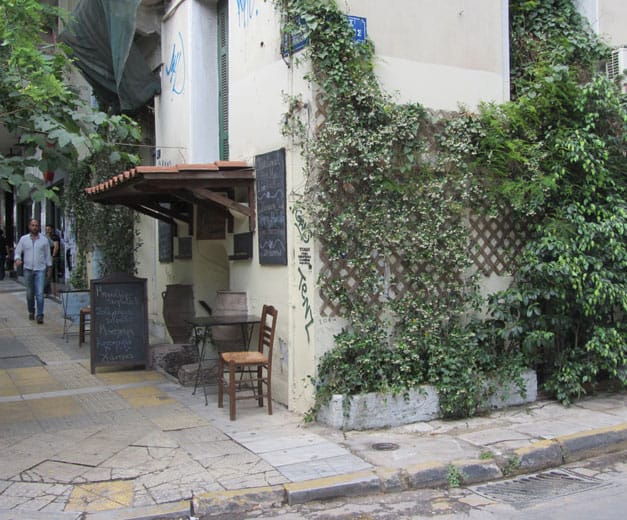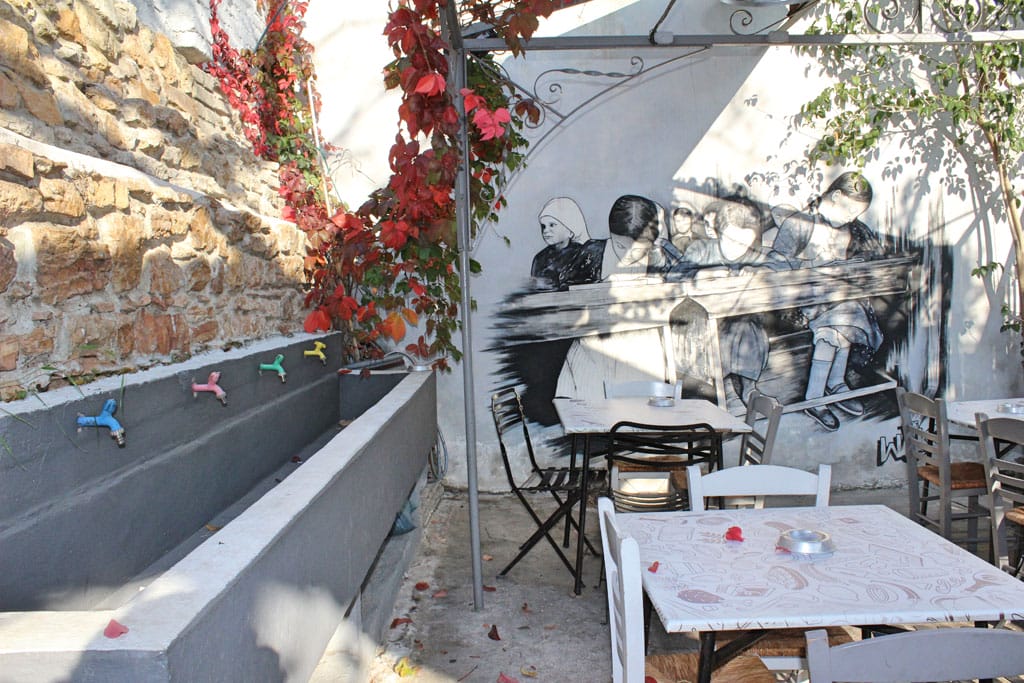What are the odds that after you’ve been to an exhibition of finds from a long-ago shipwreck you’ll end up having lunch at a place named Shipwreck of Angels? We’d been to the National Archaeological Museum in downtown Athens to see a roomful of haunting statues wrenched up from the deep off the tiny island of Antikythera. Though half the marble exposed to the saltwater was corroded and raw-looking, the torsos, limbs and faces that had lain under the sand for 2,000 years remained flawless and smooth. The sight of them was both moving and troubling, as if they were souls that should not have been disturbed.
So imagine our surprise when we stumbled upon this so appropriately named eatery a couple of blocks away. A few metal tables on the sidewalk, along with a couple of standing blackboards, advertised its existence on Stournari Street, once known as the city’s computer souk, opposite the graffiti-covered walls of the Athens Polytechnic.
With rain threatening, we resisted the urge to sit outside and people-watch and entered the Shipwreck though a low door and down three steps, almost as though we were going below decks. We chose a table in the second of three dimly lit rooms, whose walls were covered with vintage photos of Greek film stars and musicians inserted among guitars, bouzoukia and a tiny baglamas. A smiling, red-haired waitress, Marilena, put down some paper placemats decorated with line drawings and the taverna’s logo.
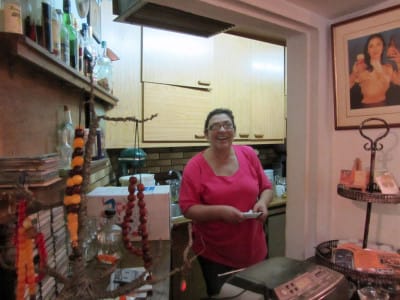 Immediately afterwards, shot glasses arrived holding a raki so smooth that we decided to keep drinking it instead of switching to wine. We discussed the menu with Marilena, who also mentioned the specials, which change every day. As the plates arrived, we greedily shared Santorini favas, leek pie, baked eggplant with cheese, flaming red Florina peppers, a tender pork fry-up and “black whitebait” (marides, or smelt), an unusual and very tasty version of a common small fried fish.
Immediately afterwards, shot glasses arrived holding a raki so smooth that we decided to keep drinking it instead of switching to wine. We discussed the menu with Marilena, who also mentioned the specials, which change every day. As the plates arrived, we greedily shared Santorini favas, leek pie, baked eggplant with cheese, flaming red Florina peppers, a tender pork fry-up and “black whitebait” (marides, or smelt), an unusual and very tasty version of a common small fried fish.
By this time we were exchanging stories with Marilena, feeling like cherished regulars, even old friends. We learned that although Navagio is open for coffee and meals from 10 a.m. to 10 p.m. on weekdays, it changes pace on Friday and Saturday nights, when it offers live music, especially rebetika, often referred to as Greek blues. We decided to see for ourselves.
The food, prepared by Kyria Jenny, the co-owner, was just as delicious that Saturday evening but the atmosphere was markedly different. A large group of hirsute young people were noisily celebrating a birthday, and a pair of Spanish tourists were getting happier and happier as they videotaped the four musicians treating us to rebetika. The ample, good-looking singer, Olga Kavvadias, in a sleeveless red dress, sang with a powerful, crystalline voice, while the mustachioed bouzouki player also sang well. Most of the pieces were unknown to us, while occasional favorites had the whole place singing along. Later, Jenny’s husband, gray-haired Stelios, picked up a guitar and sat down to play a few songs with the group as well, to general acclaim.
The indoor smoking ban is widely ignored in Athens, but the Spanish tourists must have been completely beguiled by Marilena’s answer when they asked if the establishment sold cigarettes. “No, but you can have some of mine,” she said, with typical Greek generosity. Fortunately there were enough windows and doors open that the place never got smoky. We lingered over our meal of snails in a garlicky tomato sauce, fried cod with skordalia (garlic sauce), chickpea fritters, fried “blackbait” again and halva with apple slices, washed down with raki. But people were still coming in as we paid the very reasonable bill (most main dishes on the menu are around €5 to €6, with shrimp and octopus about double that, and appetizers as low as €2.50, though dishes are 15 percent more expensive with the music), prompting my companion to remark that this place is for “after.”
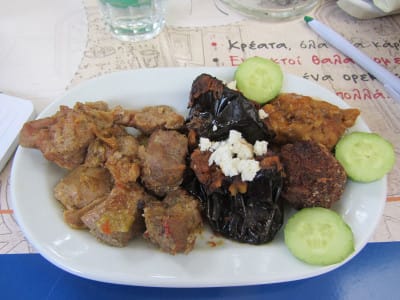 Because Navagio is such a rare, cozy place, I decided to go back at a quieter time and find out more about it. Jenny told me she starts cooking at 10, so I arrived around noon and sat outside with Marilena until she had all her katsaroles – veal stew, potatoes for skordalia, pork sautéed with wine – simmering satisfactorily. She makes everything from scratch, as if she were at home. “We are all kalofagades. We love to eat,” she said, brown eyes sparkling behind red-framed glasses.
Because Navagio is such a rare, cozy place, I decided to go back at a quieter time and find out more about it. Jenny told me she starts cooking at 10, so I arrived around noon and sat outside with Marilena until she had all her katsaroles – veal stew, potatoes for skordalia, pork sautéed with wine – simmering satisfactorily. She makes everything from scratch, as if she were at home. “We are all kalofagades. We love to eat,” she said, brown eyes sparkling behind red-framed glasses.
Housed in the basement of a derelict building owned by the state, Navagio has been around since 1958, but Jenny and Stelios acquired it in 1999, the same year their son, Orpheas, was born. “I’d had my eye on it for some time, since I worked in an accounting office nearby and used to pick up snacks there. So when I learned the proprietors were retiring, we took over, despite being new parents. The only thing we kept was the name, but I have no idea about its origin.”
She took me on a tour, explaining that, in the course of the yearlong renovation, they knocked down walls and dug up floors, removing 40 cubic meters of rubble. Now the effect is beautifully “antique.” Stelios, a marble artist, searched for period floor tiles to create attractive patterns and old bricks to fill in the walls. They did everything themselves. Even the curtains are her grandmother’s work, while the couple roamed flea markets to collect the photos, which they also framed themselves.
But “Stelios cannot live without music,” so from the beginning, music was an essential part of Navagio’s menu. “We think of it as a fytorio, a nursery for young people to learn about our country’s songs and for all music lovers to listen to old favorites and good musicians.”
Navagio is essentially a three-person outfit. Jenny does the morning shift, Stelios comes in the afternoon, and Marilena seems to be there all day, arriving around 3 p.m. on Fridays, when the place may not shut until dawn. It’s hard work, but they do it with love and kefi, welcoming both tourists and locals as if they were guests in their own home – which indeed it has become.
 July 12, 2021 The Chops Shops of Downtown Athens
July 12, 2021 The Chops Shops of Downtown Athens
If there is a symbol of the adoring relationship that Greeks have with lamb, it is none […] Posted in Athens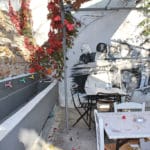 December 29, 2016 Ama Lachi stis Nefelis
December 29, 2016 Ama Lachi stis Nefelis
Through the gate on Kallidromiou and down the steps, the enchanting stone-paved […] Posted in Athens August 17, 2023 Le Greche
August 17, 2023 Le Greche
Evi Papadopoulou is no stranger to the culinary arts. A well-regarded food journalist […] Posted in Athens
Published on June 11, 2014
Related stories
July 12, 2021
AthensIf there is a symbol of the adoring relationship that Greeks have with lamb, it is none other than the lamb on a spit that most Greeks in mainland Greece eat as a specialty on Easter Sunday. Greeks eat beef or pork at least once per week; lamb, however, is not an everyday thing but…
December 29, 2016
AthensThrough the gate on Kallidromiou and down the steps, the enchanting stone-paved courtyard at last reveals itself, a hidden oasis of fragrant lemon trees, geraniums, bougainvillea and jasmine in the densely built neighborhood of Exarchia. A charming mural of children in class is painted on one side of the yard, right next to the water fountains…
August 17, 2023
AthensEvi Papadopoulou is no stranger to the culinary arts. A well-regarded food journalist who has written articles on pastries and desserts in the top Greek gastronomy publications, she is also a classically trained chef. She studied at the culinary school of renowned Italian pastry chef Iginio Massari and followed that up with specialized training in…







































